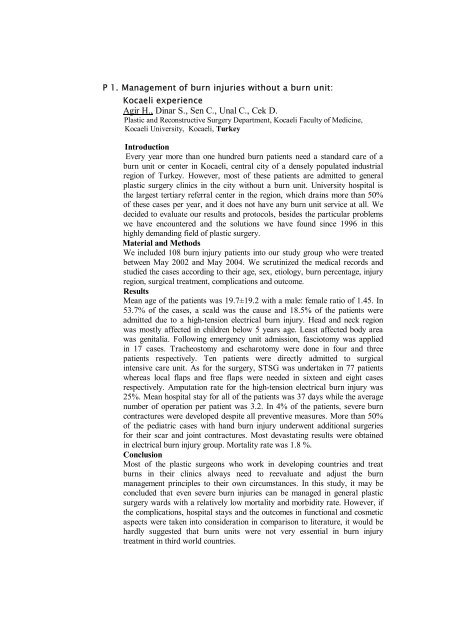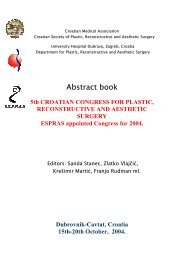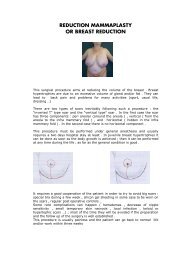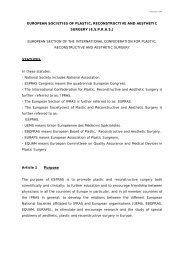Abstract book - ESPRAS
Abstract book - ESPRAS
Abstract book - ESPRAS
Create successful ePaper yourself
Turn your PDF publications into a flip-book with our unique Google optimized e-Paper software.
P 1. Management of burn injuries without a burn unit:<br />
Kocaeli experience<br />
Agir H., Dinar S., Sen C., Unal C., Cek D.<br />
Plastic and Reconstructive Surgery Department, Kocaeli Faculty of Medicine,<br />
Kocaeli University, Kocaeli, Turkey<br />
Introduction<br />
Every year more than one hundred burn patients need a standard care of a<br />
burn unit or center in Kocaeli, central city of a densely populated industrial<br />
region of Turkey. However, most of these patients are admitted to general<br />
plastic surgery clinics in the city without a burn unit. University hospital is<br />
the largest tertiary referral center in the region, which drains more than 50%<br />
of these cases per year, and it does not have any burn unit service at all. We<br />
decided to evaluate our results and protocols, besides the particular problems<br />
we have encountered and the solutions we have found since 1996 in this<br />
highly demanding field of plastic surgery.<br />
Material and Methods<br />
We included 108 burn injury patients into our study group who were treated<br />
between May 2002 and May 2004. We scrutinized the medical records and<br />
studied the cases according to their age, sex, etiology, burn percentage, injury<br />
region, surgical treatment, complications and outcome.<br />
Results<br />
Mean age of the patients was 19.7±19.2 with a male: female ratio of 1.45. In<br />
53.7% of the cases, a scald was the cause and 18.5% of the patients were<br />
admitted due to a high-tension electrical burn injury. Head and neck region<br />
was mostly affected in children below 5 years age. Least affected body area<br />
was genitalia. Following emergency unit admission, fasciotomy was applied<br />
in 17 cases. Tracheostomy and escharotomy were done in four and three<br />
patients respectively. Ten patients were directly admitted to surgical<br />
intensive care unit. As for the surgery, STSG was undertaken in 77 patients<br />
whereas local flaps and free flaps were needed in sixteen and eight cases<br />
respectively. Amputation rate for the high-tension electrical burn injury was<br />
25%. Mean hospital stay for all of the patients was 37 days while the average<br />
number of operation per patient was 3.2. In 4% of the patients, severe burn<br />
contractures were developed despite all preventive measures. More than 50%<br />
of the pediatric cases with hand burn injury underwent additional surgeries<br />
for their scar and joint contractures. Most devastating results were obtained<br />
in electrical burn injury group. Mortality rate was 1.8 %.<br />
Conclusion<br />
Most of the plastic surgeons who work in developing countries and treat<br />
burns in their clinics always need to reevaluate and adjust the burn<br />
management principles to their own circumstances. In this study, it may be<br />
concluded that even severe burn injuries can be managed in general plastic<br />
surgery wards with a relatively low mortality and morbidity rate. However, if<br />
the complications, hospital stays and the outcomes in functional and cosmetic<br />
aspects were taken into consideration in comparison to literature, it would be<br />
hardly suggested that burn units were not very essential in burn injury<br />
treatment in third world countries.







